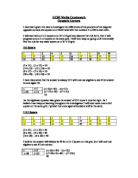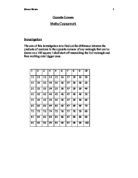40
This proves that the answer is always 40 when a 3 x 3 square is placed on a 10 x 10 grid.
I am now going to use a 4 x 4 square on a 10 x 10 grid. The only difference will be that I will only use algebra as numbers are very time consuming.
4 x 4 square
(n+3)(n+30) – n(n+33)
(n2+30n+3n+90) – (n2+33n)
90
As I am doing so well I will continue to go on to a 5 x 5 square on the 10 x 10 grid.
5 x 5 Square
(n+4)(n+40) – n(n+44)
(n2+40n+4n+160) – (n2+44n)
160
I am now going to create a table displaying my results so far
I have noticed a pattern: the opposite corners are all square numbers of the square before multiplied by 10. Hence forth I predict that the product form the 6 x 6 square will have a difference of 250, I will now try it and see if my prediction is correct.
(n+5)(n+50) – n(n+55)
(n2+50n+5n+250) – (n2+55n)
250
I was correct. I will now attempt to convert my verbal rule into algebraic terms for any square on a 10 x 10 grid.
(n+(m-1))(n+10(m-1)) – n(n+11(m-1))
(n2+10n(m-1)+n(m-1)+10(m-1) 2)-(n2+11n(m-1))
10(m-1) 2
I have now discovered the rule for any square on a 10 x 10 grid I am now going to try and find a general rule which will allow me to work out on any square on any grid. As the rule for any square on a 10 x 10 grid is 10(m-1) 2 I predict that if were to use a 7 x 7 grid the rule would be 7(m-1) 2 . I will now see if I am correct. However I will once again only use algebra as numbers are too time consuming. I will use a 2 x 2 square on the grid to start with.
2 x 2 square
(n+1)(n+7) – n(n+8)
(n2+7n+n+7) – (n2+8n)
7
I think I have already spotted a trend as this occurred when I completed the work for the 10 x 10 grid. I think the rule for any square on a 7 x 7 grid will be 7(m-1) 2
I will now try to see if I am correct.
(n+(m-1)(n+7(m-1)) – n(n+8(m-1))
n2+7n(m-1)+n(m-1)+7(m-1) 2
7(m-1) 2
The answer is exactly what I predicted I am now going to find a general rule for any square (m x m) on any grid (g x g). This is what my grid would look like…
Here is the process I will use to solve the general rule:
n+(m-1)(n+g(m-1)) – n(n(m-1)(g+1))
(n2+ng(m-1)+n(m-1)+g(m-1) 2
(n2+n(g+1)(m-1)+g(m-1) 2) – (n2+n(m-1)(g+1))
g(m-1) 2
Now I have completed my aims and found the general rule I will not have to use numbers again to find the opposite corners of a square. I have done this through progressive investigation and through algebraic methods. I have taken this piece of coursework as far as I can with squares and I am therefore going to progress onto using rectangles as they are similar shapes. As I have done lots of number and algebra work finding the formula for individual squares I am simply going to find the general rule straight away for any rectangle on any grid.
The letters I will use are:
L: the length of the rectangle must be bigger than 1 and equal to or smaller than the grid
size.
H: the height of the rectangle. This is a non-restrictive measurement if it is required to be
as extra rows can be added easily to the bottom of the grid. Must be a whole positive
integer
G: The grid size which must be at least 2 x 2 upwards so that it has opposing corners. It
must also be a whole, positive integer.
(n+(L-1))(n+G(H-1)) – n(n+G(H-1)+(L-1))
n2+nG(H-1)+n(L-1)+(G(L-1)(H-1)) – (n2+nG(H-1)+n(L-1))
G(L-1)(H-1)
I have found my rule for any rectangle on any size of grid the algebraic rule is
G(L-1)(H-1) or subtract one from the length and one from the height and multiply by the grid size. I have completed the extension of the original task and did no think I could progress any further. However I discovered one aspect that I have not even mentioned before the difference between the numbers in the grid. For instance I could instead of having; 1, 2, 3, 4, 5… I could have; 2, 4, 6, 8, 10… as I have in the last few investigations I will only use algebra as numbers as well are to time consuming.
These are the algebraic terms I will use in my formulae:
L: the length of the rectangle must be bigger than 1 and equal to or smaller than the grid
size.
H: the height of the rectangle. This is a non-restrictive measurement if it is required to be
as extra rows can be added easily to the bottom of the grid. Must be a whole positive
integer
G: The grid size which must be at least 2 x 2 upwards so that it has opposing corners. It
must also be a whole, positive integer.
S: The gap between the two numbers can be any number; positive, negative, decimals,
Fractions etc.
This is what my grid would look like
This is how I will work out the rule for any rectangle on any sized grid with any gap size between the numbers.
(n+S(L-1))(n+GS(H-1) – n(n+s(L-1)+GS(H-1))
(n2+nGS(H-1)+ns(L-1)+S2G(L-1)(H-1)) – (n2+ns(L-1)+nGS(H-1)
S2G(L-1)(H-1)
For Example
So if:
S= -0.1
G= 5
L=2
H=3
S2G(L-1)(H-1)
0.01 x 5 x 1 x 2 = 0.1
For Example
(21.9 x 21) – (22 x 20.9)
459.9 – 459.8
0.01
In conclusion I feel I have gone as far as possible with this investigation as I have covered all aspects of it as I can possibly think off. I am very happy with my results and have enjoyed doing this investigation.








